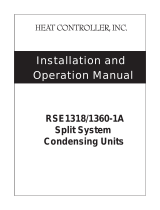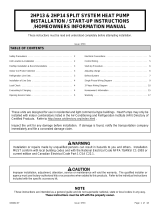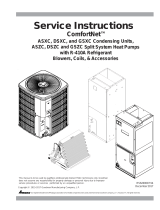Page is loading ...

816050
14 SEER CONDENSING UNIT
INSTALLER'S INFORMATION MANUAL
ATTENTION, INSTALLER!
After installing the
system, show the user how to turn off electricity to the unit.
Point out control and switch locations for turning off
electricity. Make sure the user understands the importance
of following all safety precautions, including what could
happen if they don't.
Keep the following documents in a safe, accessible
location. Tell the user where these documents are located:
• Installer's Information Manual
• Parts List
• Warranty Information
While these instructions have been written as accurately
and thoroughly as possible, they may not cover every
system variation or contingency. Questions of
interpretation may arise. For more information, solutions to
particular problems or clarification, contact your local
distributor or the manufacturer.
ATTENTION, USER!
Your equipment installer
should give you the important documents listed above. You
should become familiar with these instructions, as it will be
helpful in avoiding any needless service costs or
operational problems. Keep these instructions as long as
you keep your equipment for future reference. If any of the
documents are missing or illegible, contact your installer or
equipment manufacturer for replacement.
Throughout this manual, when we use the word "you" we
refer to the qualified service technician who is responsible
for application, installation and service of your equipment.
While these instructions are addressed primarily to the
installer, useful maintenance information is included. Have
your installer acquaint you with the operating characteristics
of the product and periodic maintenance requirements.
WARNING:
Individuals who install this equipment, must have the training and experience necessary to install comfort
air conditioning appliances. Before performing any work on this equipment, the power supply must be turned off at the
household service box. Improper installation could void the warranty; create a hazard, resulting in the possibility of damage,
injury or death.

Page 2 Installer’s Information Manual
TABLE OF CONTENTS
SECTION 1. GENERAL INFORMATION................................................................................2
SECTION 2. MEETING CODES .............................................................................................3
SECTION 3. DETERMINING CONDENSER LOCATION ....................................................... 3
SECTION 4. REFRIGERANT PIPING CONNECTIONS ......................................................... 4
SECTION 5. ELECTRICAL CONNECTION ............................................................................ 5
SECTION 6. REFRIGERANT CHARGE .................................................................................6
SECTION 7. CHECKOUT PROCEDURE ...............................................................................7
SECTION 8. MAINTENANCE .................................................................................................7
SECTION 9. TROUBLE-SHOOTING CHART......................................................................... 9
SECTION 1. GENERAL
INFORMATION
These instructions cover the installation of the following split
system 14 SEER condensing unit. The dimensions are
illustrated in Figure 1. Physical and electrical specifications
are provided in Table 2.
Read this manual and any instructions packaged with
separate equipment required to make up the system prior to
installation.
The outside unit is designed to be placed alongside or at
the back of the home, remote from the indoor coil. The
outdoor unit has been factory run-tested and all
components of the system are ready for easy, immediate
installation.
WARNING: These instructions are intended as an
aid to licensed service personnel. Improper installation may
damage equipment, void the warranty, and can create a
hazard, resulting in injury or death.
A thorough inspection of the shipping container should be
made immediately upon receiving your unit. Look for any
punctures or openings, and if it appears that damage has
occurred, it should be noted on the freight bill before
signing. The delivering carrier should be contacted
immediately to inspect damage, and no installation work
should begin until this inspection is completed. The
manufacturer assumes no responsibility for installation of
incorrectly shipped units.
To alert you to potential hazards, we use the signal words
"WARNING" and "CAUTION" throughout this manual.
"WARNING" alerts you to situations that could cause or
result in serious injury or death. "CAUTION" alerts you to
situations that could cause or result in minor or moderate
injury or property damage. For a safe and reliable
installation be sure to read and follow all warnings and
cautions.
We also use the words "must" and "should" in this manual.
"Must" is mandatory. "Should" is advisory.
CAUTION: The manufacturer is not responsible
for the performance of a mismatched system. The outdoor
unit must be installed with a compatible indoor unit as
designated in the specification data or in the Directory of
Certified Unitary Air Conditioners published by the Air
Conditioning and Refrigeration Institute. Using unmatched
components may not only affect the performance of the
system but may also void the warranty of the equipment
SERIES NOMENCLATURE
2 AC 14 042 A S M 1
REFRIGERANT
2 = R22
4 = R410a
UNIT TYPE
AC = Air Conditioner
HP = Heat Pump
SERIES
13 = 13 SEER Condensing Unit
14 = 14 SEER Condensing Unit
16 = 16 SEER Condensing Unit
5# = 50 Hz Condensing Unit
NOMINAL COOLING CAPACITY
018 = 18,000 BTUH 042 = 42,000 BTUH
024 = 24,000 BTUH 048 = 48,000 BTUH
030 = 30,000 BTUH 060 = 60,000 BTUH
036 = 36,000 BTUH
VOLTAGE
A = 208/230-1-60 D = 575-3-60
B = 208/230-3-60 E = 230-1-50
C = 460-3-60 F = 380/415-3-50
COMPRESSOR
R = Reciprocating Compressor
S = Scroll Compressor
CONDENSER COIL
C = Plate-fin/Tube Coil
M = Aluminum Microchannel Coil
PRODUCT GENERATION
# = Revision Number


Page 4 Installer’s Information Manual
A minimum clearance of 18 inches is required for service at
the control panel access. A 12 inch clearance is required
for the air inlet to the outdoor coil around the perimeter of
the unit. The air discharge of the unit requires a 60 inch
clearance between the top of the unit and any obstruction.
See Figure 2.
The length of the refrigerant tubing, between the outdoor
unit and indoor coil, should be as short as possible to avoid
capacity and efficiency loss. Excessive spacing of the
outdoor unit from the home can lead to the refrigerant lines
being restricted by trampling or by being punctured by lawn
mowers. Locate the outdoor unit away from bedroom
windows or other rooms where sound might not be
desirable.
Provide sufficient clearance from shrubs to allow adequate
air to pass across the outdoor coil without leaves or
branches being pulled into the coil.
Consideration should be given to the distance and routing
of electrical service that would have to be run to connect
the outdoor unit.
The outdoor unit may be installed at ground level on a solid
base that will not shift or settle, causing strain on the
refrigerant lines and possible leaks. Isolate the base from
the structure to avoid noise or vibration transmission.
When installing units on a roof, a structure should be used
to minimize the transmission of sound or vibration into the
conditioned space. Thought should be given to water
drainage away from the outdoor unit. Drain holes in the
base pan must be kept clear.
12" Clearance
around unit
18" Clearance
for Service Area
60" Clearance
Above Unit
To Indoor Coil
NEC Class 1
Wiring
Power
Supply
NEC Class 2
Wiring
Thermostat
To Indoor Air Handler
or Furnace
Figure 2. Typical Location and Clearances
SECTION 4. REFRIGERANT PIPING
CONNECTIONS
Undersized line sets will increase the refrigerant pressure
drop between the indoor evaporator and outdoor unit,
resulting in a decrease in system capacity. Over sizing the
line sets may result in excessive refrigerant charge, thereby
making the system more susceptible to liquid migration.
Slope horizontal vapor lines at least 1” every 20 feet toward
the outdoor unit to facilitate proper oil return.
Use only refrigerant grade (dehydrated and sealed) copper
tubing of the size indicated in Table 1 to interconnect the
condensing unit with the indoor evaporator. Take extreme
care to keep the refrigerant tubing clean and dry prior to
and during installation. All outdoor unit and evaporator coil
connections are copper to copper and should be brazed
with a phosphorous-copper alloy material such as Silfos-5
or equivalent instead of soft solder. The outdoor units have
re-usable service valves on both the liquid and vapor
connections. Precautions should be taken to prevent heat
damage to the valve by wrapping a wet rag around it when
brazing.
Do not remove plugs from ends of tubing until connection is
ready to be made. Suction line insulation is necessary to
prevent condensation from forming on and dropping from
suction line. Apply suction line insulation by sliding it on the
sealed tubing before cutting and making connections. See
Table 1 for correct vapor line size.


Page 6 Installer’s Information Manual
5. Be sure to ground the condensing unit by securing the
ground wire to the grounding lug inside the control
box.
6. Be sure to follow National Electrical Code and all local
codes
NOTE: Use copper conductors only.
CAUTION: Casing or cabinet must be
permanently grounded in accordance with National Electric
Code or other applicable local codes.
SECTION 6. REFRIGERANT
CHARGE
Condensing units are supplied with a refrigerant charge (R-
22) sufficient for typical matching evaporator and
approximately 25 feet of interconnecting tubing.
Condensing unit liquid and suction valves are closed to
contain the charge within the unit.
MEASUREMENT
If a calibrated charging cylinder or accurate weighing device
is available, add refrigerant accordingly.
CAUTION: Refrigerant charging should only be
carried out by a qualified air conditioning contractor.
FIELD CHARGING
Depending on the type of restricting device that is installed
on the system (TXV, piston, capillary tubes, etc.), the
subcooling or superheat charging method can be used for
field charging or checking the existing refrigerant charge in
a system. Because each installation is different in terms of
indoor air flow, refrigerant line length, and duct variations,
etc., the factory charge may not be correct for every
application. To assure the best performance from the air
conditioner, the refrigerant charge should be checked and
adjusted when needed on each installation.
CAUTION: Compressor damage will occur if
system is improperly charged. On new system installations,
charge the system per refrigerant charge information label
and follow guidelines in these instructions.
WARNING: Refrigerant is under pressure. Guard
against refrigerant spraying into the face or on skin. Always
wear protective equipment, i.e. safety glasses or goggles
and gloves when working with refrigerant.
SUBCOOLING CHARGING METHOD
The subcooling charging method is to be used on units
which have Thermostatic Expansion Valve (TXV) as the
expansion device. For proper subcooling readings, a
standard high side gauge is required for pressure readings.
1. Measure the outdoor air temperature. (T1)
2. Measure the liquid line pressure at the outdoor unit
and determine condenser refrigerant temperature by
the scale on the high side pressure gauge. (T2)
3. Measure the liquid line temperature on the liquid line at
the outdoor unit. (T3)
4. Subtract T3 from T2. (T2 – T3) This is the subcooling
value. Compare this value and the outdoor
temperature (T1), to the chart on page 8 (Figure 3). If
the value is below the line, add refrigerant. If the value
is above the line, remove refrigerant charge.
NOTE: When removing refrigerant, always use standard
reclaim procedures.
NOTE: On cooler days (65degF or lower), attempts to
operate the air conditioner and take gauged pressure
readings may be unsuccessful, as unusually low pressures
will be observed on the suction line. This type of operation
may give the impression of an undercharged unit. Such is
NOT necessarily the case. The low-pressure reading may
exist because of the large condenser surface area and the
cold ambient air removing so much heat from the
refrigerant. Sub-cooling occurs and results in very low
pressures. Adding refrigerant in cold weather will result in
an overcharged unit, which may then trip out on high
pressure limit during warm or hot weather. Line pressures
should not be taken for test purposes when the outdoor
temperature is below 70degF since a false reading may
occur. Do not attempt to operate the air conditioner on a
day of 45degF or cooler.

Installer’s Information Manual Page 7
SECTION 7. CHECKOUT
PROCEDURE
CHECKOUT PROCEDURE
Use the following list to see that nothing was over looked:
1. Have all braze joints on refrigerant lines been leak
checked?
2. Line set fittings leak checked?
3. Have base valves been opened?
4. Have all refrigerant lines been secured and isolated
properly?
5. Is the indoor coil drain hooked up and draining freely?
Pour water in drain pan.
6. Is air filter installed and clean?
7. Is the blower motor speed set correctly?
NOTE: Installer should place unit data sheet and
installation instruction in customer packet and give to home
owner after installation is complete.
SYSTEM OPERATION CHECKOUT
1. With thermostat set to the OFF position, close
disconnect switch or switches to complete circuits to
condensing unit and furnace. Set thermostat to call
for cooling.
2. After the system starts, check the voltage and
amperage at the condensing unit contactor.
3. If voltage is not within 10% of rated voltage, or
amperage greatly exceeds nameplate amperage, shut
down the system and contact the local power
company for corrections; otherwise unsatisfactory
performance many result.
4. With the system in operation, check the condensing
unit for unusual noise and undue vibration.
5. Allow the system to operate until it is balanced or
stabilized (approximately 30 minutes), before making
further checks.
6. Remove manifold gage hoses, and install cap on
Schrader valves.
SECTION 8. MAINTENANCE
CAUTION: Be sure the unit disconnect is in the
OFF position and that all electrical power to the unit is
turned off before cleaning the system.
The following maintenance points should be reviewed
annually:
INDOOR
• The evaporator coil should be inspected for
blockages.
• Vacuum or spray the coil fins with water to remove
dust and dirt.
OUTDOOR
•
Remove leaf or debris blockage from the
condenser.
• Clean the condenser coil by spraying it with clean
water from a garden hose.
• Spray water from inside of the coil outward. Avoid
wetting any electrical controls.
NOTE: Change air filters monthly to keep the airflow path
clean.
If unit is not operating properly, check the following items:
• The indoor section for dirty filter and outdoor
section for leaf or debris blockage.
• If the compressor has shutdown on thermal-
overload due to dirty filter or blockage, it may be
necessary to wait 2 hours to cool before the unit
will restart.
• If the temperature setting on the thermostat is low
enough to bring the air conditioner on and system
still does not start, call a service technician.

Page 8 Installer’s Information Manual
Subcooling Chart for units with Thermostatic Expansion Valves
4
6
8
10
12
14
16
18
60 65 70 75 80 85 90 95 100 105 110 115
OUTDOOR TEMPERATURE (deg F)
SUBCOOLING (deg F)
Remove Refrigerant
Add Refrigerant
Figure 3. Subcooling Charging Chart

Installer’s Information Manual Page 9
SECTION 9. TROUBLE-SHOOTING CHART
WARNING: Disconnect all power to unit before servicing. Failure to shut off power can cause electrical shock resulting
in personal injury or death.
Symptom Possible Cause Correction
Unit will not operate
• Power disconnected or loose connection
• Blown fuse / breaker tripped
• Thermostat out of calibration – set too high
• Contactor defective
• Transformer defective
• High pressure control open (if provided)
• Check voltage at contactor in condensing unit
• Replace fuses / reset breaker
• Reset
• Check for 24VAC at contactor coil – replace if
open
• Check wiring – replace transformer
• Reset – see high pressure correction (high
pressure control opens at 450 psig)
Outdoor fan on;
Compressor off
• Run or start capacitor defective
• Start relay defective
• Loose wire
• Compressor stuck, grounded or open motor
w
inding, open internal overload
• Low voltage condition
• Replace
• Replace
• Check for correct voltage at compressor –
c
heck and tighten all connections
• Wait at lease 2 hours for overload to reset; if
s
till open, replace the compressor
• Add start kit components
Too little cooling
• Improperly sized unit
• Improper indoor airflow
• Incorrect refrigerant charge
• Air, non-condensibles or moisture in system
• Recalculate load
• Check – should be approximately 400 CFM
per ton
• Charge per procedure in installation manual
• Recover refrigerant, evacuate and recharge,
replace filter drier
Compressor operates in
short cycles
• Incorrect voltage
• Defective overload protector
• Refrigerant undercharge
• At compressor terminals, voltage must be +/-
10% of nameplate marking when unit is
operating
• Replace – check for correct voltage
• Add refrigerant
High head pressure;
Low suction pressure
• Restriction in liquid line, expansion device or filter
drier
• Lack of sufficient indoor airflow
• Remove or replace defective component
• Clean/check filters, registers, or evaporator
coil that may cause a restriction.
High head pressure;
Normal suction pressure
• Dirty outdoor coil
• Refrigerant overcharge
• Outdoor fan not running
• Air or non-condensibles in system
• Clean coil
• Correct system charge
• Repair or replace
• Recover refrigerant, evacuate and recharge
Low head pressure;
High suction pressure
• Expansion device stuck in open position
• Defective compressor valves
• Replace expansion device
• Replace compressor
Low suction pressure;
Compressor cool;
Ice on indoor coil
• Low indoor airflow
• Operating below 65degF outdoors
• Moisture in system
• Increase speed of blower or reduce restriction
– replace air filter
• Add low ambient kit
• Recover refrigerant – evacuate and recharge
–
replace filter drier
High suction pressure;
Or fluctuating head and
suction pressures
• Excessive load
• Defective compressor
• TXV hunting
• Air or non-condensibles in system
• Recheck load calculation
• Replace
• Check TXV bulb clamp – check air distribution
on coil – replace TXV
• Recover refrigerant, evacuate and recharge
Pulsing noise at expansion
device or liquid line
• Air or non-condensibles in system • Recover refrigerant, evacuate and recharge
Registers sweat
• Low indoor airflow • Increase speed of blower or reduce restriction
– replace air filter
/


